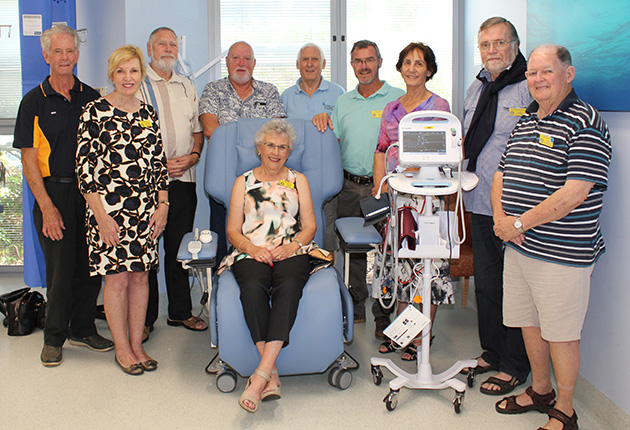Nov
24
Australian First at MNCCI Thanks to the Coffs Community
An investment in wireless technology has been made possible in Coffs Harbour thanks to support from Coffs Coast Rotarians and the Prostate Cancer Support Group. The investment makes Mid North Coast Cancer Institute (MNCCI) the first cancer centre in Australia to use technology to interface and integrate its vital signs monitors with an oncology-specific electronic medical record system.
The project:
- reduces the need for nurses to write down patient data
- eliminates the risk of mistakes occurring during the transcribing process
- enables ‘real time’ clinical decisions to be made based on accurate and immediate patient observations such blood pressure, pulse rate and respiration
The project, however, was dependent on the cancer unit upgrading its vital signs monitors to models that could use wireless technology to record and transmit clinical observations and then relay it to the nursing station, enabling timely interventions as well as maintaining an accurate record of patient vital signs.
Had Rotary Club of Coffs Harbour Daybreak not heard of the initiative and the potential benefits for patients, the project may never have got off the ground.
“Quite simply, we could not have even considered taking this approach to patient care had it not been for the Rotarians and Prostate Cancer Support Group,” said MNCCI’s Nursing and Service Development Manager, Jill Harrington.
“We had the skills to make it happen, but we needed help from the community to fund it.”
Over ninenteen months and with the help of other Rotary Clubs, six new monitors have been donated at a cost of $52,800. This means the project is up and running and gaining great results. The Rotarians are hoping to have the final four monitors funded by the end of next year.
As well as help from the Rotarians and Prostate Cancer Support Group, MNCCI have brought together technical experts from Asia and the United States to work with their own highly skilled team in bringing the concept to fruition. Now there is future scope to include height and weight records, medications, patient tracking and linking the system to biomedical equipment.
“It’s been a challenge, but we are thrilled with the results,” Ms Harrington said. “Now that it is up and running, other sites are looking to us to see how we did it and how it benefits our patients.”
Well done to all involved.
Previous Story
November 2018: New Applications and Smart Devices Unveiled for Healthcare
Next Story
Promoting Better Value in Care Provision through Alliancing: Prospects for Australia


 We acknowledge the traditional custodians of the land we live and work, the Bundjalung, Arakwal, Yaegl, Gumbaynggirr, Githabul, Dunghutti and Birpai Nationsand their continuing connection to land, sea and community. We pay our respects to elders past, present and future.
We acknowledge the traditional custodians of the land we live and work, the Bundjalung, Arakwal, Yaegl, Gumbaynggirr, Githabul, Dunghutti and Birpai Nationsand their continuing connection to land, sea and community. We pay our respects to elders past, present and future.
